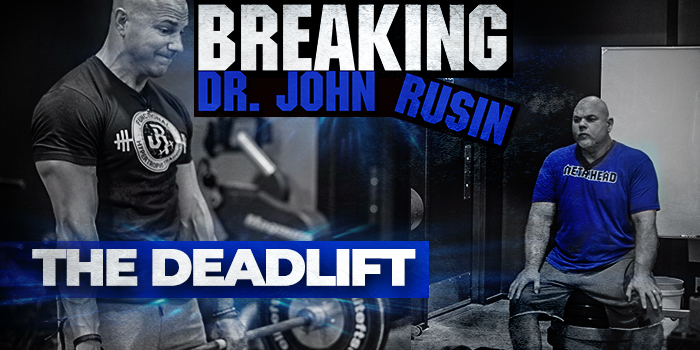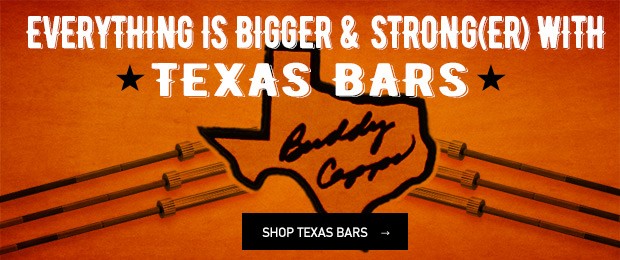
Rusin recently joined Tate for an individual coaching session to break down his deadlift technique. Together, they discuss everything from proper body positioning, to variations on the deadlift, to strategic accessory work to support the movement. Tate provides targeted cues and instruction designed specifically for Rusin’s build – learnings that Rusin can take back to his own gym and incorporate as a part of his training program to bolster the “big three” lifts. If you haven't already, be sure to watch Dave break down Rusin's squat and bench.
Shoulder Positioning
As they kick off the session, Tate explains that he always coaches the deadlift from the side, as opposed to the front. This is because it provides a better vantage point for him to see shoulder positioning, a crucial component of effective deadlift technique. Tate states that the shoulder joint should be in line with or behind the bar at all times. When the shoulders are in front of the bar, the movement actually becomes more Olympic weightlifting than powerlifting, and tends to put added stress on the spine.
PART 1: WATCH: Breaking John Rusin — The Squat
As part of maintaining proper shoulder positioning, Tate coaches Rusin to relax his arms and upper back to avoid being overly tense. To illustrate his point, Tate equates it to the feeling at the bottom of a barbell shrug, in which the hands are dropped by the side of the body. Once Rusin makes the proper adjustment, he gains roughly three inches on his deadlift – and in powerlifting, every inch matters. Many people tend to miss the lift or lose their grip because they make the mistake of being in too tight of a position. It’s expert tips like this that help lifters to relax appropriately in order to successfully execute the movement.
Conventional Vs. Modified Sumo
As Rusin moves from a conventional deadlift to a modified sumo variation, it’s clear that this movement is different for him. He seems to have less of a “ritual” when approaching the lift. This could be due to the fact that in comparison to the squat and the bench press, Rusin executes deadlifts much less frequently. However, another contributing factor could be the fact that Rusin’s build is better-suited to pull conventional deadlifts as opposed to modified sumo pulls.
As such, Tate explains that Rusin’s sequence and set-up for a conventional deadlift should be different than how he prepares for a modified sumo variation. When it comes to the conventional deadlift, Rusin should tap his hands on his quads to verify that his hands are in the correct position – down low by the side of his body, with his upper back relaxed. On the other hand, for the modified sumo, Rusin should start off closer to the bar and go down into the lift with more of a flared movement, as opposed to sitting back. He should then grab the center of the bar with one hand first, which serves to keep his shoulders squared as opposed to tilted. Finally, he should bring the other hand around and slide it out on the bar to prepare for the pull. Despite the fact that Rusin manages to improve his modified sumo pull with cues from Tate, it is likely that he will stick to building the conventional deadlift. As Tate puts it, due to his structure, the conventional deadlift looks stronger, healthier, and safer for him.
Breathing Sequence
Conversations on proper breathing return once again, this time within the context of the deadlift. Tate and Rusin already worked to incorporate proper breathing – first in through the nose, and then in through the mouth – into his squat technique. As Rusin adds it into his deadlift sequence as well, he notices an immediate difference in his performance. Proper breathing, as he puts it, is a total “game-changer.” In fact, Rusin seems to want to simply make this way of breathing a habit during his training:
From a recreational strength athlete like myself that’s looking to be as strong as possible, I always think about repeatable motor tasks. Just for the sake of simplicity, would you say that because my deadlift and my squat should be cued a certain way, I should just try to push it over to the bench press as well, and just habituate that stuff?
The answer to his question is yes, with regard to any movement that involves heavy weight and low repetitions. Tate explains that his biggest fear with the higher reps is that lifters will start out fine, but then get fatigued on rep six or seven and forget to breathe. This can often lead to injury because it instantly takes away what was previously a strong, braced base. Although this sequence of breathing doesn’t necessarily work for every powerlifter out there, it’s certainly worth trying out given its success in Rusin’s training thus far.
Accessory Work
They conclude the session by talking through key accessory exercises that ultimately help to enhance deadlift performance. A central component of this discussion is glute-ham raises. Rusin comments on how he’s incorporated them into his own training program, asking Tate as to whether or not they are worthwhile to do in terms of accessory work:
I’ve seen a big carryover between linking my hamstrings and my lower back. Previously, we’d do a little bit of lower back training, but we just didn’t have the means to do any serious loading of the glutes, plus the hamstrings, and the lower back together. That’s something new that I’ve put into training…Do you think that’s something that I should keep in, in terms of accessory work?
Nodding, Tate explains that for everyone he works with at his facility, glute ham raises are a mandatory part of warm-ups during every session, along with hanging leg raises and bent knee reverse hyperextensions. This allows athletes to “cover all the bases” and ensure that they are appropriately elongating their hip-flexors. Additionally, Tate also emphasizes there are many different ways that lifters can load a glute-ham raise without putting a barbell on their backs. Med ball throws, rounded ball glute-ham raises, and an occasional Yoke Bar are all options that are generally safe and help protect the back. Tate notes that he particularly likes anything that athletes can round over (like a ball), because this rounded movement keeps the back in a neutral position and forces the hamstrings to engage.
PART 2: Breaking John Rusin — The Bench Press
Lifters can wave each one of these accessory movements, usually getting by with three times of one variation before it has to change. Naturally, as lifters execute these movements over time, the number of repetitions will usually go up. Tate mentions that unloading isn’t really necessary if these movements are part of the warm-up protocol. Rusin nods in agreement, explaining that he plans to pull these exercises into session warm-ups in the future, making them more of a habitual part of that “activation phase” of training. Indeed, by regularly activating his glutes and hamstrings at the outset of his training sessions, Rusin stands to see significant gains in his deadlift performance.










1 Comment